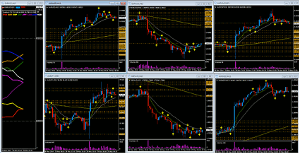When trading, it is always better to keep an open mind instead of being wedded to a fixed idea, as demonstrated by recent trick that was played on those holding short positions in Aussie cross pairs, notes Anna Coulling of AnnaCoulling.com.
There is always a huge debate about whether it is better to be a technical trader or a fundamental trader. Technical traders believe they are right and everyone else is wrong, whilst fundamental traders take the opposing view and believe technical analysis is no better than voodoo. My own belief is that to succeed you need a blend of both.
The overnight trading session, Tuesday, delivered a master class in how having such entrenched views can trip up both camps equally.
The fundamental release in question was the quarterly release in Australia for Private Capital Expenditure. It was a red flag release and therefore one likely to cause a strong reaction in the Australian dollars and its cross pairs. This release is important because it measures the change in the total inflation adjusted value of new capital expenditures made by private business. In other words it is leading indicator for economic growth.
The forecast number was -1.6% with the actual coming in at -4.2%-a huge discrepancy. Simple logic would suggest that on such a bad number the Aussie should sell off. In fact the complete opposite happened leaving many traders scratching their heads as to the reason why. However, the explanation is very straightforward for several reasons.
First, fundamental releases do not operate in a vacuum but are part of a continuum and it is extremely rare for a single number to reverse any longer-term trend. In this case, the number to watch was how the actual compared with the previous quarter, which had seen an even worse number at -4.5%. In other words, -4.2% was actually a modest improvement on the previous quarter, and whilst below the market's unrealistic expectation, this was nevertheless positive news, and something many traders failed to grasp. And indeed this is the point.
It is not the number itself, which is important, but how it fits into the overall trend of previous releases for that data set. In addition, the initial sell off was the big market operators taking out all the shorts in the process, all those traders who jumped on board thinking this was an easy trade to the short side following a poor number. All these traders were promptly stopped out as the Aussie rallied. Patience as always is a virtue!
This price action can be clearly seen on the 15-minute chart of the AUD/USD and it was replicated across the Aussie currency matrix.

Aussie currency matrix
Click to Enlarge
A question technical traders might ask is how can the price action be validated at such times? And the answer is, of course, volume or more precisely volume price analysis which signals to traders clearly and instantly whether any move is genuine or not.
Going back to where we started, my own belief is that as traders the only approach is to combine the technical with the fundamental, and in this case an awareness of this release would be key and be reflected in the price action. Indeed, prior to any major release price simply moves in consolidation as it waits for the news. Then it's simply a question of waiting for the price action to be validated with volume.
By Anna Coulling, Professional Trader & Blogger, AnnaCoulling.com





















